Key Role of Transfer Layer in Load Dependence of Friction on Hydrogenated Diamond-Like Carbon Films in Humid Air and Vacuum
Abstract
1. Introduction
2. Experimental Material and Methods
2.1. Preparation of H-DLC Film
2.2. Test Methods
3. Results
3.1. Characterization of H-DLC Film
3.2. Friction Behaviors of H-DLC Films in Humid Air and Vacuum
3.3. Wear Behaviors of H-DLC Films in Humid Air and Vacuum
4. Discussion
4.1. Structure Evolution of H-DLC Film after Sliding in Humid Air and Vacuum
4.2. Formation of Transfer Layer on The Counterface and Environment Dependence
4.3. Stability of Low-Friction State on H-DLC Surface in Humid Air and Vacuum
5. Conclusions
- (1)
- The load dependence of friction behaviors on H-DLC film strongly depends on the surrounding environment. The running-in stage only occurs at high normal load conditions following a relatively low-friction coefficient in humid air. By contrast, the friction can decrease to a superlubricity state at low load conditions but can easily fail at high loads in vacuum.
- (2)
- The contribution of H-DLC substrate surface graphitization to a sharp drop in friction was ruled out in all cases. In humid air, the transfer layer on the counterface formed at relatively high loads plays a key role in the sharp drop of the friction coefficient. In vacuum, the transfer layer can be formed at low load conditions, resulting in a superlow friction coefficient. However, the formed transfer layer cannot be maintained for a long time at relatively high loads.
- (3)
- The lifetime of the low-friction state after the running-in process is determined by the formation and stability of the transfer layer on the counterface under both humid air and vacuum conditions. The friction coefficient decreases to a relatively low level at a high enough load in humid air. Conversely, the superlubricity realized in vacuum can only be maintained for a long time at a low load.
Author Contributions
Funding
Conflicts of Interest
References
- Fontaine, J. Towards the use of diamond-like carbon solid lubricant coatings in vacuum and space environments. Proc. Inst. Mech. Eng. Part J 2008, 222, 1015–1029. [Google Scholar] [CrossRef]
- Scharf, T.W.; Prasad, S.V. Solid lubricants: A review. J. Mater. Sci. 2012, 48, 511–531. [Google Scholar] [CrossRef]
- Donnet, C. Recent progress on the tribology of doped diamond-like and carbon alloy coatings: A review. Surf. Coat. Technol. 1998, 100–101, 180–186. [Google Scholar] [CrossRef]
- Zahid, R.; Masjuki, H.H.; Varman, M.; Kalam, M.A.; Mufti, R.A.; Mohd Zulkifli, N.W.B.; Gulzar, M.; Nor Azman, S.S.B. Influence of intrinsic and extrinsic conditions on the tribological characteristics of diamond-like carbon coatings: A review. J. Mater. Res. 2016, 31, 1814–1836. [Google Scholar] [CrossRef]
- Robertson, J. Diamond-like amorphous carbon. Mater. Sci. Eng. R Rep. 2002, 37, 129–281. [Google Scholar] [CrossRef]
- Cui, L.; Lu, Z.; Wang, L. Environmental effect on the load-dependent friction behavior of a diamond-like carbon film. Tribol. Int. 2015, 82, 195–199. [Google Scholar] [CrossRef]
- Bai, L.; Srikanth, N.; Wu, H.; Liu, F.; Liu, B.; Zhou, K. Effect of environmental hydrogen atoms on the tribological behaviors of diamond-like carbon films. Tribol. Int. 2016, 99, 258–266. [Google Scholar] [CrossRef]
- Ji, L.; Li, H.; Zhao, F.; Quan, W.; Chen, J.; Zhou, H. Effects of environmental molecular characteristics and gas–surface interaction on friction behavior of diamond-like carbon films. J. Phys. D Appl. Phys. 2009, 42, 135301. [Google Scholar] [CrossRef]
- Guo, J.; Wang, Y.; Liang, H.; Liang, A.; Zhang, J. Mechanical properties and tribological behavior of fullerene-like hydrogenated carbon films prepared by changing the flow rates of argon gas. Appl. Surf. Sci. 2016, 364, 288–293. [Google Scholar] [CrossRef]
- Andersson, J.; Erck, R.A.; Erdemir, A. Friction of diamond-like carbon films in different atmospheres. Wear 2003, 254, 1070–1075. [Google Scholar] [CrossRef]
- Vanhulsel, A.; Velasco, F.; Jacobs, R.; Eersels, L.; Havermans, D.; Roberts, E.W.; Sherrington, I.; Anderson, M.J.; Gaillard, L. DLC solid lubricant coatings on ball bearings for space applications. Tribol. Int. 2007, 40, 1186–1194. [Google Scholar] [CrossRef]
- Donnet, C.; Mogne, T.L.; Ponsonnet, L.; Belin, M.; Grill, A.; Patel, V.; Jahnes, C. The respective role of oxygen and water vapor on the tribology of hydrogenated diamond-like carbon coatings. Tribol. Lett. 1998, 4, 259–265. [Google Scholar] [CrossRef]
- Liu, E.; Ding, Y.F.; Li, L.; Blanpain, B.; Celis, J.P. Influence of humidity on the friction of diamond and diamond-like carbon materials. Tribol. Int. 2007, 40, 216–219. [Google Scholar] [CrossRef]
- Yang, S.H.; Kong, H.; Lee, K.-R.; Park, S.; Kim, D.E. Effect of environment on the tribological behavior of Si-incorporated diamond-like carbon films. Wear 2002, 252, 70–79. [Google Scholar] [CrossRef]
- Konca, E.; Cheng, Y.T.; Weiner, A.M.; Dasch, J.M.; Alpas, A.T. Vacuum tribological behavior of the non-hydrogenated diamond-like carbon coatings against aluminum: Effect of running-in in ambient air. Wear 2005, 259, 795–799. [Google Scholar] [CrossRef]
- Donnet, C.; Grill, A. Friction control of diamond-like carbon coatings. Surf. Coat. Technol. 1997, 94–95, 456–462. [Google Scholar] [CrossRef]
- Xia, L.; Li, G. The frictional behavior of DLC films against bearing steel balls and Si3N4 balls in different humid air and vacuum environments. Wear 2008, 264, 1077–1084. [Google Scholar] [CrossRef]
- Liu, Y.; Yu, B.; Cao, Z.; Shi, P.; Zhou, N.; Zhang, B.; Zhang, J.; Qian, L. Probing superlubricity stability of hydrogenated diamond-like carbon film by varying sliding velocity. Appl. Surf. Sci. 2018, 439, 976–982. [Google Scholar] [CrossRef]
- Xiao, C.; Li, J.; Gong, J.; Chen, L.; Zhang, J.; Qian, L.; Luo, J. Gradual degeneration of liquid superlubricity: Transition from superlubricity to ordinary lubrication, and lubrication failure. Tribol. Int. 2019, 130, 352–358. [Google Scholar] [CrossRef]
- Liu, Y.A.N.; Meletis, E.I. Evidence of graphitization of diamond-like carbon films during sliding wear. J. Mater. Sci. 1997, 32, 3491–3495. [Google Scholar] [CrossRef]
- Liu, Y.; Erdemir, A.; Meletis, E.I. An investigation of the relationship between graphitization and frictional behavior of DLC coatings. Surf. Coat. Technol. 1996, 86–87, 564–568. [Google Scholar] [CrossRef]
- Chen, X.; Kato, T.; Nosaka, M. Origin of superlubricity in a-C:H:Si films: A relation to film bonding structure and environmental molecular characteristic. ACS Appl. Mater. Interfaces 2014, 6, 13389–13405. [Google Scholar] [CrossRef] [PubMed]
- Scharf, T.W.; Singer, I.L. Role of Third Bodies in Friction Behavior of Diamond-like Nanocomposite Coatings Studied by In Situ Tribometry. Tribol. Trans. 2002, 45, 363–371. [Google Scholar] [CrossRef]
- Manimunda, P.; Al-Azizi, A.; Kim, S.H.; Chromik, R.R. Shear-Induced Structural Changes and Origin of Ultralow Friction of Hydrogenated Diamond-like Carbon (DLC) in Dry Environment. ACS Appl. Mater. Interfaces 2017, 9, 16704–16714. [Google Scholar] [CrossRef]
- Erdemir, A. The role of hydrogen in tribological properties of diamond-like carbon films. Surf. Coat. Technol. 2001, 146–147, 292–297. [Google Scholar] [CrossRef]
- Erdemir, A.; Eryilmaz, O.L.; Nilufer, I.B.; Fenske, G.R. Synthesis of superlow-friction carbon films from highly hydrogenated methane plasmas. Surf. Coat. Technol. 2000, 133–134, 448–454. [Google Scholar] [CrossRef]
- Konicek, A.R.; Grierson, D.S.; Sumant, A.V.; Friedmann, T.A.; Sullivan, J.P.; Gilbert, P.U.P.A.; Sawyer, W.G.; Carpick, R.W. Influence of surface passivation on the friction and wear behavior of ultrananocrystalline diamond and tetrahedral amorphous carbon thin films. Phys. Rev. B 2012, 85, 155448. [Google Scholar] [CrossRef]
- Kim, D.-W.; Kim, K.-W. Effects of sliding velocity and normal load on friction and wear characteristics of multi-layered diamond-like carbon (DLC) coating prepared by reactive sputtering. Wear 2013, 297, 722–730. [Google Scholar] [CrossRef]
- Casiraghi, C.; Ferrari, A.C.; Robertson, J. Raman spectroscopy of hydrogenated amorphous carbons. Phys. Rev. B 2005, 72, 085401. [Google Scholar] [CrossRef]
- Prawer, S.; Nugent, K.W.; Lifshitz, Y.; Lempert, G.D.; Grossman, E.; Kulik, J.; Avigal, I.; Kalish, R. Systematic variation of the Raman spectra of DLC films as a function of sp2:sp3 composition. Diam. Relat. Mater. 1996, 5, 433–438. [Google Scholar] [CrossRef]
- Song, H.; Ji, L.; Li, H.; Liu, X.; Zhou, H.; Wang, W.; Chen, J. Perspectives of friction mechanism of a-C:H film in vacuum concerning the onion-like carbon transformation at the sliding interface. RSC Adv. 2015, 5, 8904–8911. [Google Scholar] [CrossRef]
- Xu, Z.; Zheng, Y.J.; Jiang, F.; Leng, Y.X.; Sun, H.; Huang, N. The microstructure and mechanical properties of multilayer diamond-like carbon films with different modulation ratios. Appl. Surf. Sci. 2013, 264, 207–212. [Google Scholar] [CrossRef]
- Liu, Y.; Zhang, B.; Chen, L.; Cao, Z.; Shi, P.; Liu, J.; Zhang, J.; Qian, L. Perspectives of the Friction Mechanism of Hydrogenated Diamond-Like Carbon Film in Air by Varying Sliding Velocity. Coatings 2018, 8, 331. [Google Scholar] [CrossRef]
- Cao, Z.; Zhao, W.; Liang, A.; Zhang, J. A General Engineering Applicable Superlubricity: Hydrogenated Amorphous Carbon Film Containing Nano Diamond Particles. Adv. Mater. Interfaces 2017, 4, 1601224. [Google Scholar] [CrossRef]
- Jiang, J.; Zhang, S.; Arnell, R.D. The effect of relative humidity on wear of a diamond-like carbon coating. Surf. Coat. Technol. 2003, 167, 221–225. [Google Scholar] [CrossRef]
- Akaishi, A.; Yonemaru, T.; Nakamura, J. Formation of Water Layers on Graphene Surfaces. ACS Omega 2017, 2, 2184–2190. [Google Scholar] [CrossRef]
- Donnet, C.; Fontaine, J.; Grill, A.; Le Mogne, T. The role of hydrogen on the friction mechanism of diamond-like carbon films. Tribol. Lett. 2001, 9, 137–142. [Google Scholar] [CrossRef]
- Scharf, T.W.; Ohlhausen, J.A.; Tallant, D.R.; Prasad, S.V. Mechanisms of friction in diamondlike nanocomposite coatings. J. Appl. Phys. 2007, 101, 063521. [Google Scholar] [CrossRef]
- Zhang, P.; He, H.; Chen, C.; Xiao, C.; Chen, L.; Qian, L. Effect of abrasive particle size on tribochemical wear of monocrystalline silicon. Tribol. Int. 2017, 109, 222–228. [Google Scholar] [CrossRef]
- Li, H.; Xu, T.; Wang, C.; Chen, J.; Zhou, H.; Liu, H. Tribochemical effects on the friction and wear behaviors of a-C:H and a-C films in different environment. Tribol. Int. 2007, 40, 132–138. [Google Scholar] [CrossRef]
- Qi, Y.; Konca, E.; Alpas, A.T. Atmospheric effects on the adhesion and friction between non-hydrogenated diamond-like carbon (DLC) coating and aluminum—A first principles investigation. Surf. Sci. 2006, 600, 2955–2965. [Google Scholar] [CrossRef]
- Cui, L.; Lu, Z.; Wang, L. Probing the low-friction mechanism of diamond-like carbon by varying of sliding velocity and vacuum pressure. Carbon 2014, 66, 259–266. [Google Scholar] [CrossRef]
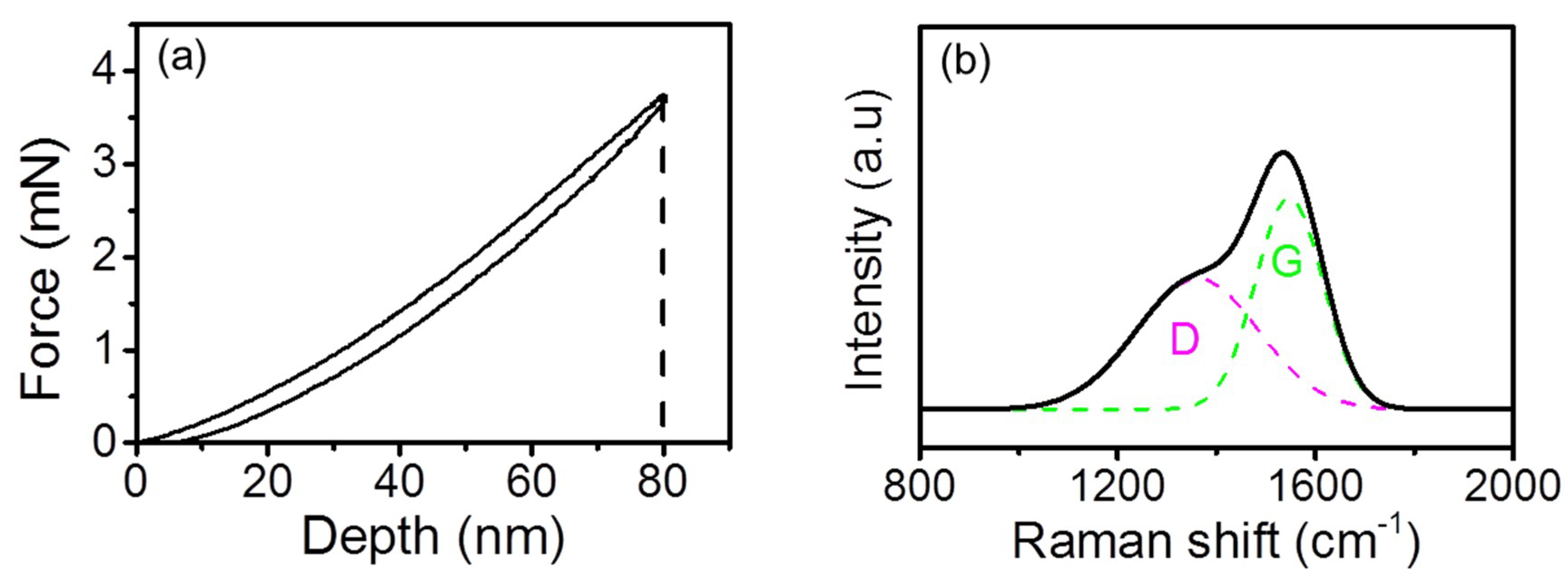
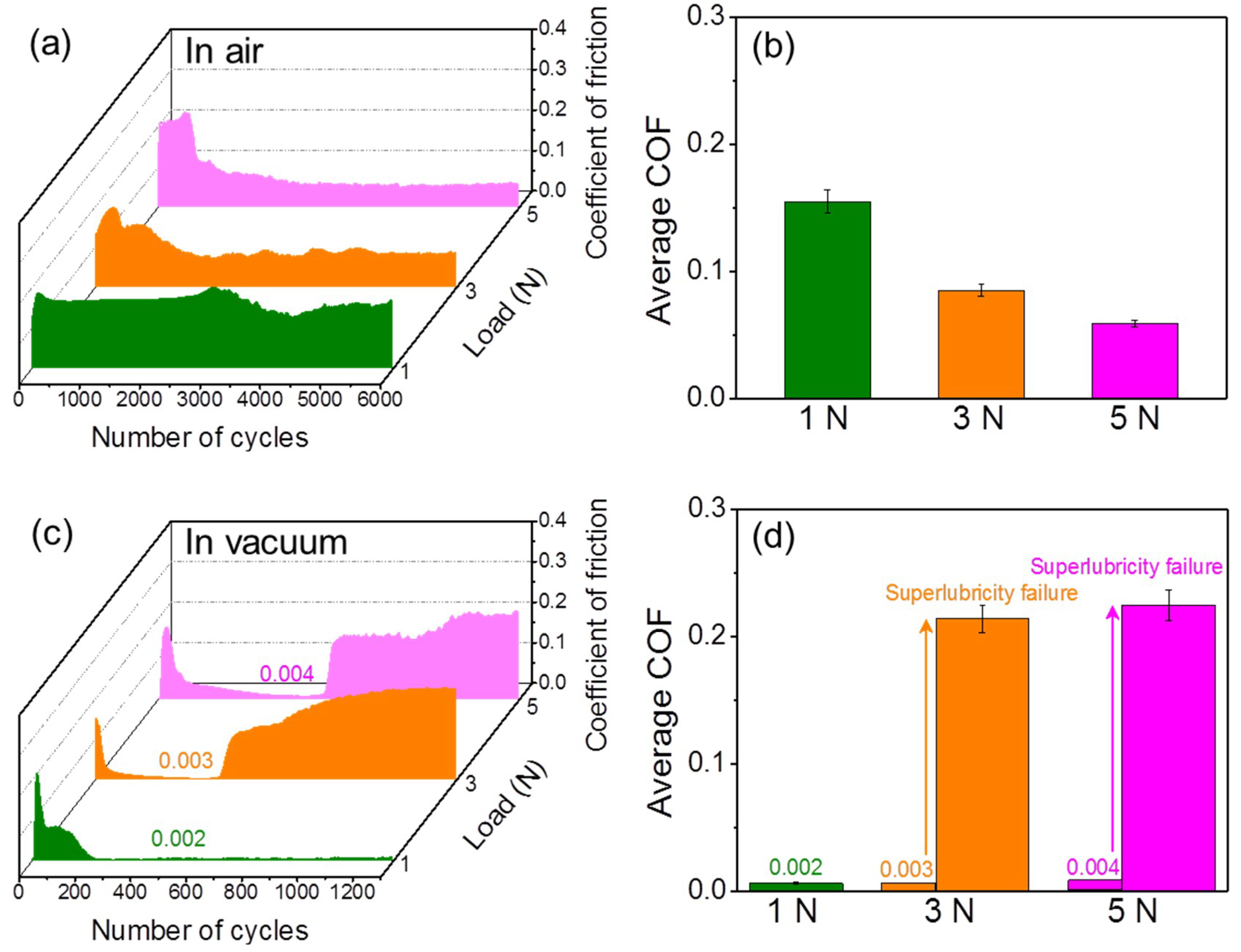
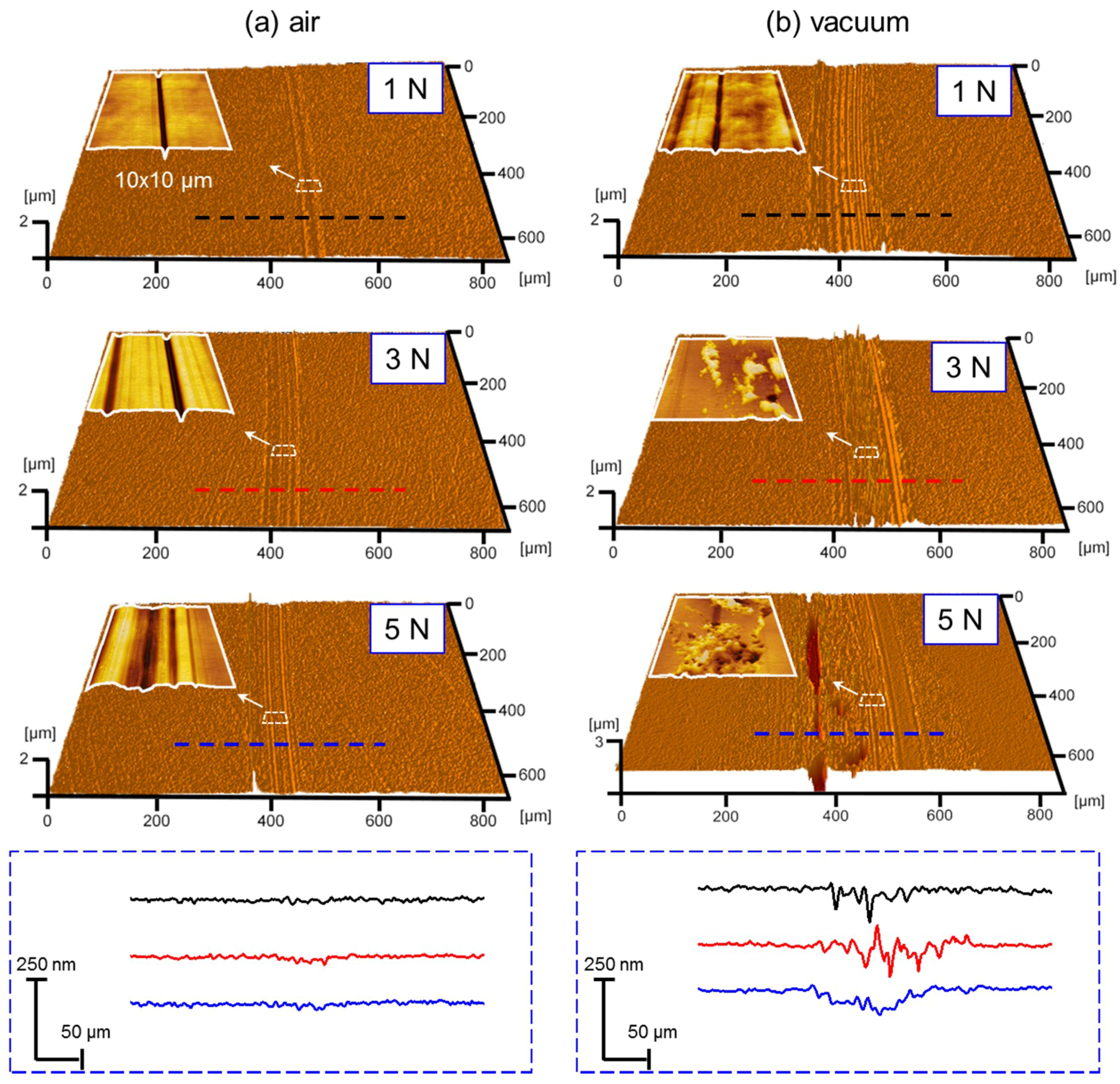
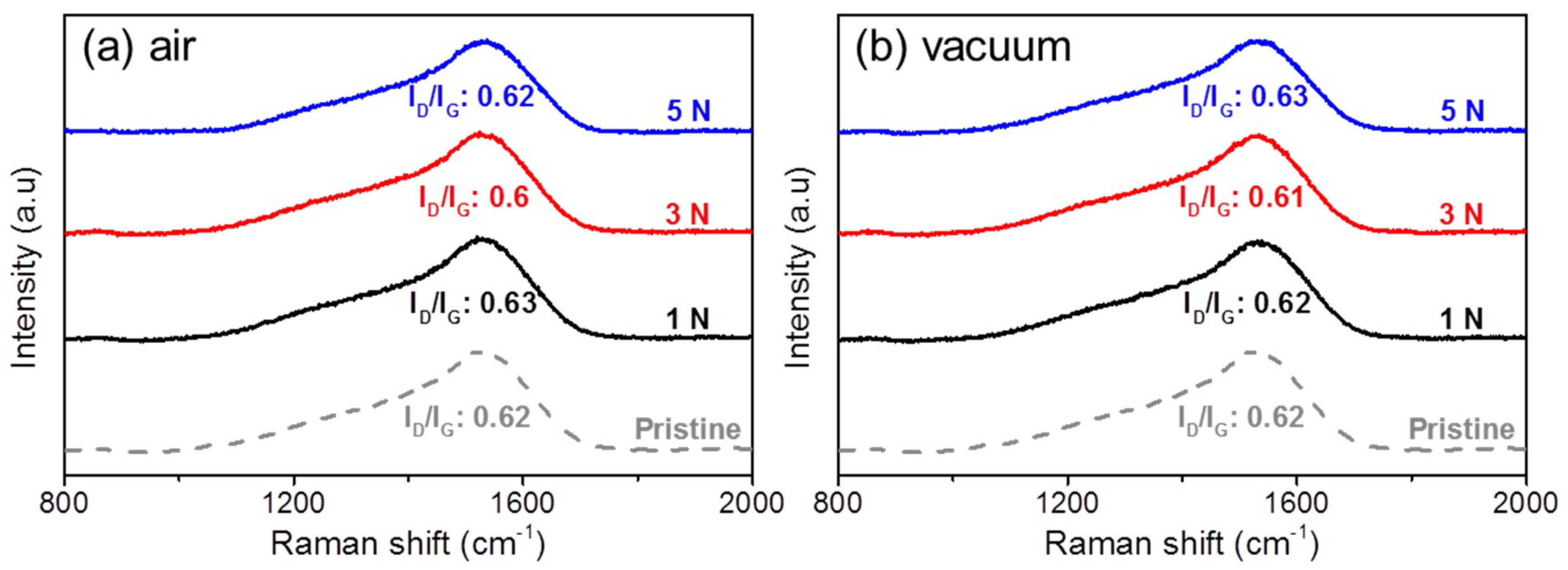
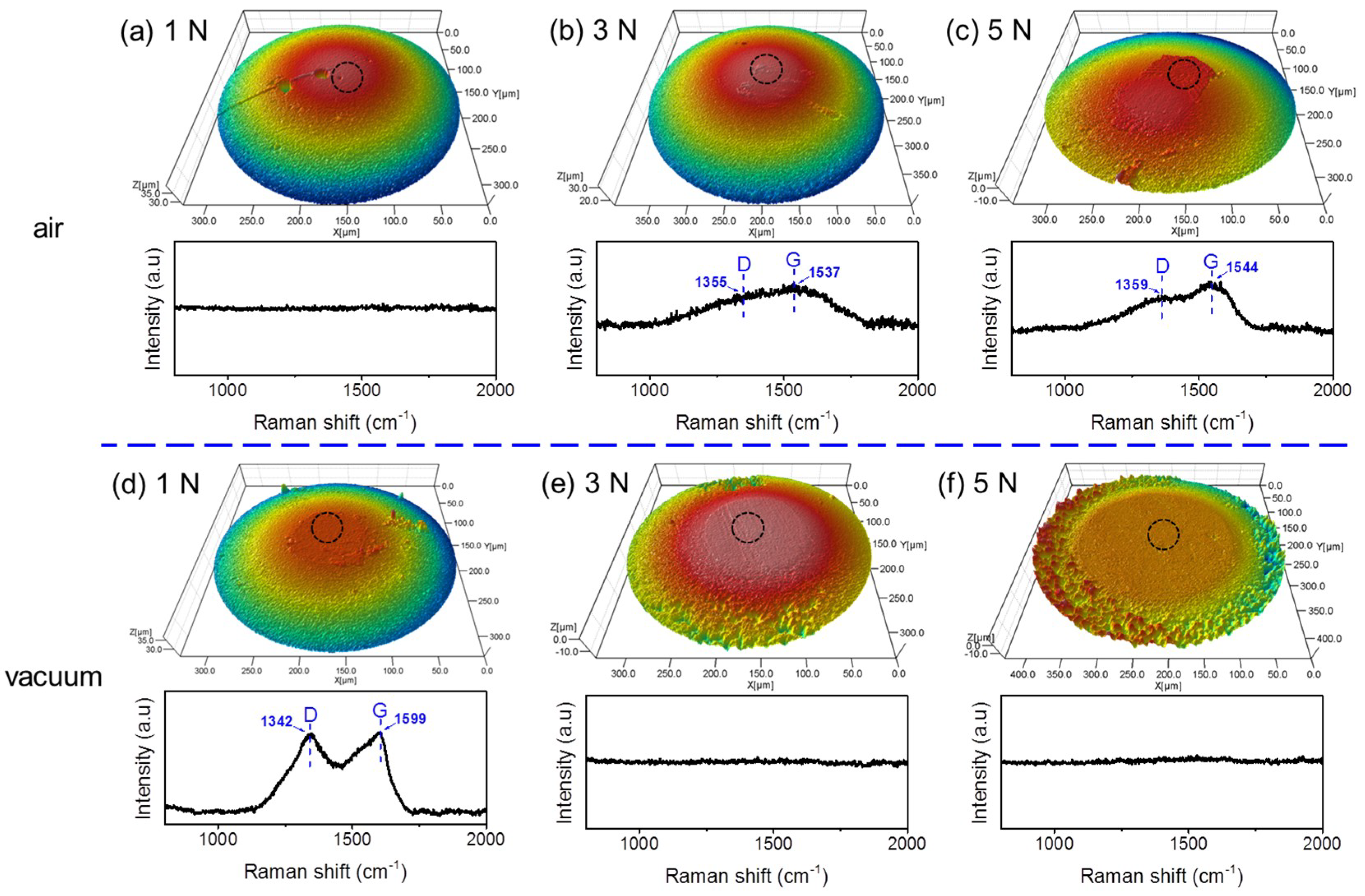
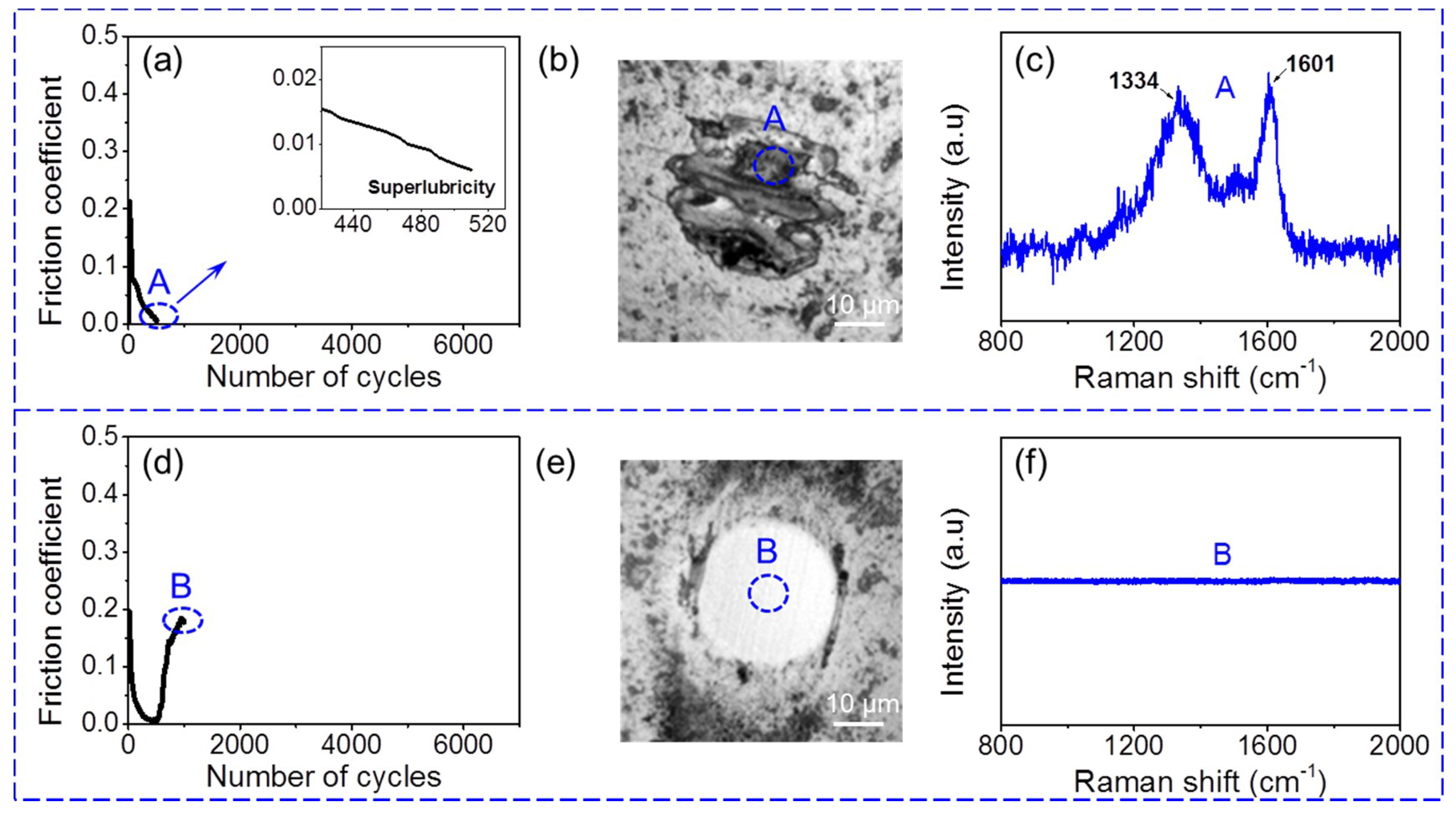
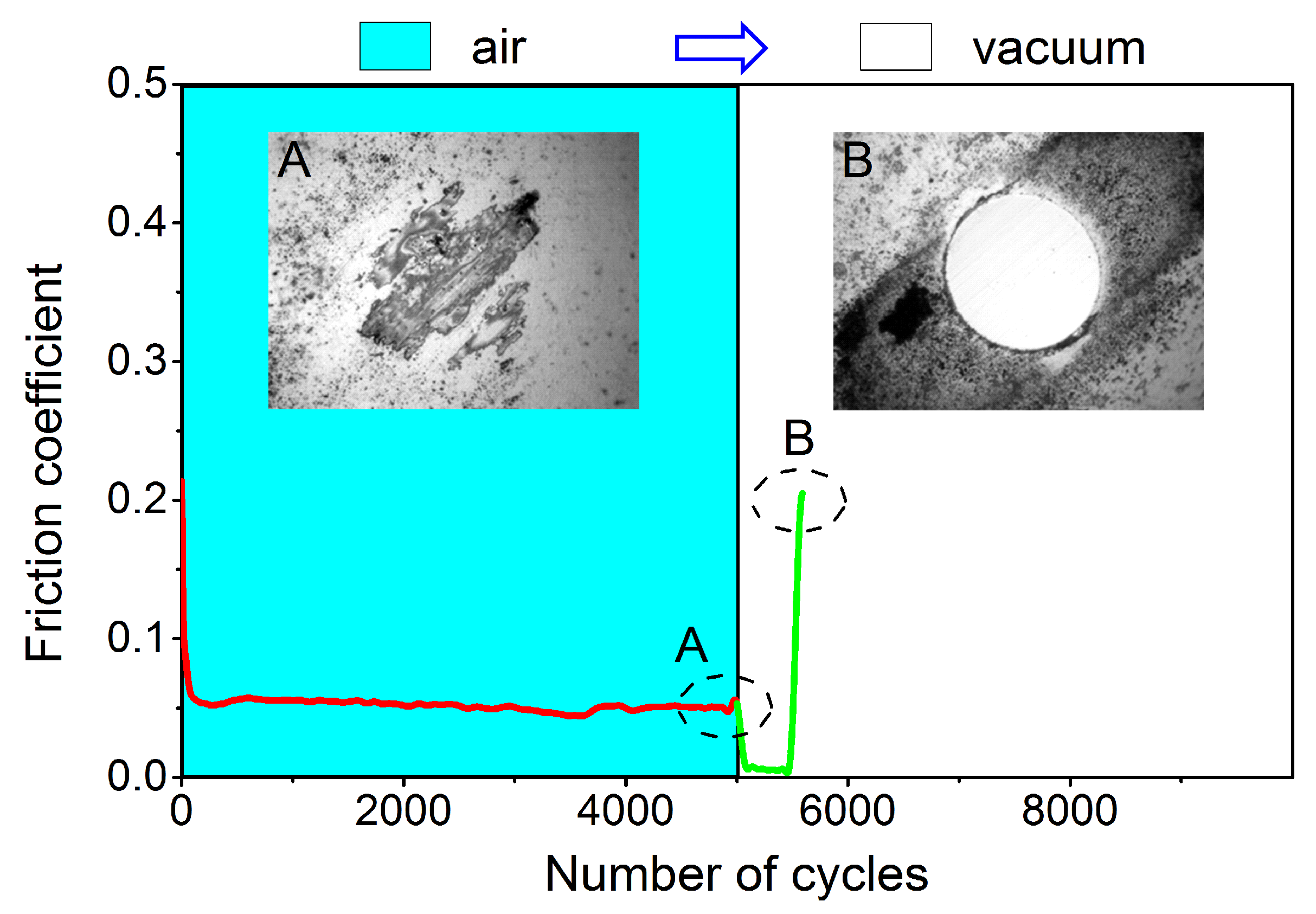
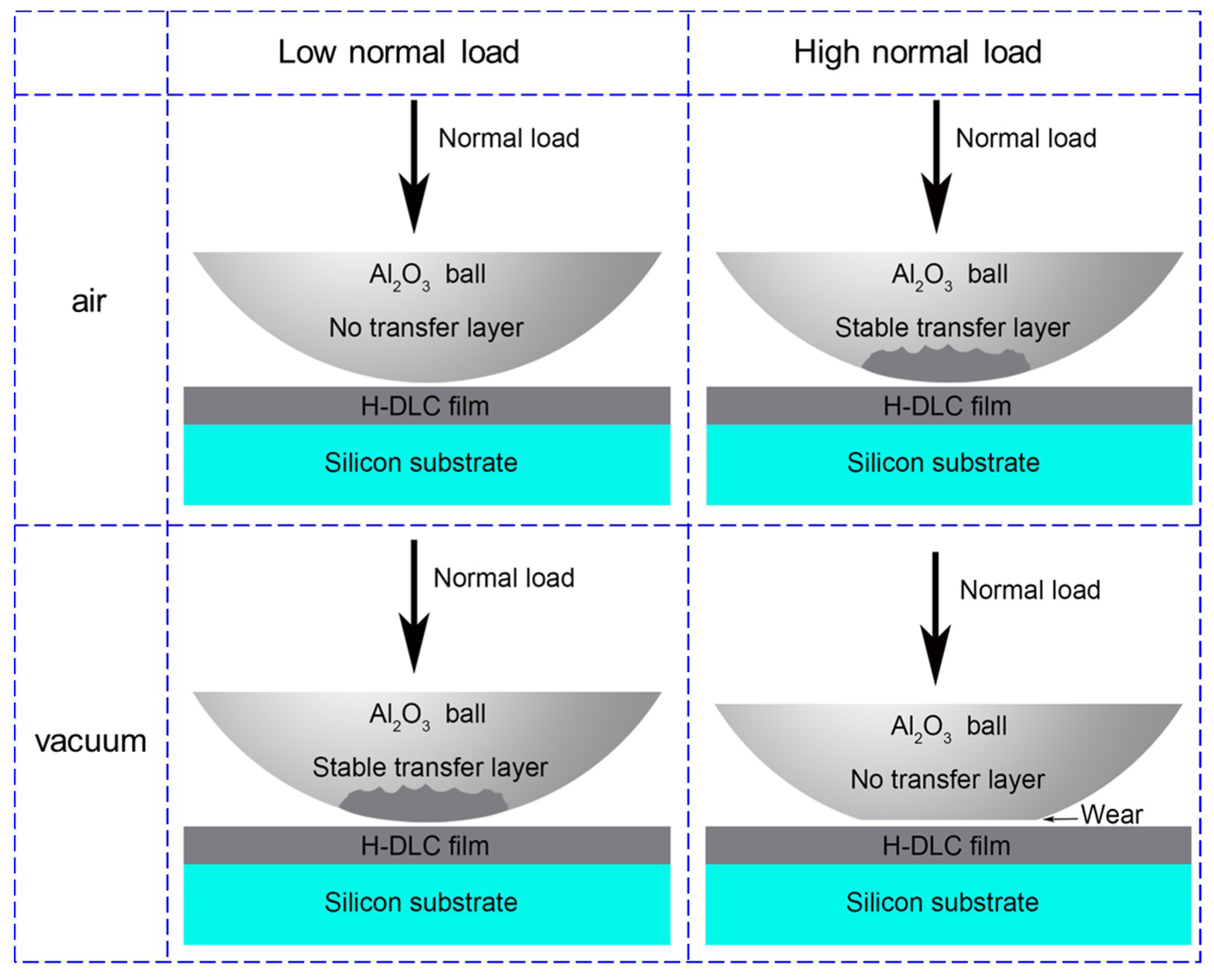
| Sample | Thickness | RMS Roughness | Hardness | Elastic Modulus | ID/IG |
|---|---|---|---|---|---|
| H-DLC film | ~870 nm | ~0.18 ± 0.04 nm | ~11.6 GPa | ~117.3 GPa | ~0.62 |
© 2019 by the authors. Licensee MDPI, Basel, Switzerland. This article is an open access article distributed under the terms and conditions of the Creative Commons Attribution (CC BY) license (http://creativecommons.org/licenses/by/4.0/).
Share and Cite
Liu, Y.; Chen, L.; Zhang, B.; Cao, Z.; Shi, P.; Peng, Y.; Zhou, N.; Zhang, J.; Qian, L. Key Role of Transfer Layer in Load Dependence of Friction on Hydrogenated Diamond-Like Carbon Films in Humid Air and Vacuum. Materials 2019, 12, 1550. https://doi.org/10.3390/ma12091550
Liu Y, Chen L, Zhang B, Cao Z, Shi P, Peng Y, Zhou N, Zhang J, Qian L. Key Role of Transfer Layer in Load Dependence of Friction on Hydrogenated Diamond-Like Carbon Films in Humid Air and Vacuum. Materials. 2019; 12(9):1550. https://doi.org/10.3390/ma12091550
Chicago/Turabian StyleLiu, Yunhai, Lei Chen, Bin Zhang, Zhongyue Cao, Pengfei Shi, Yong Peng, Ningning Zhou, Junyan Zhang, and Linmao Qian. 2019. "Key Role of Transfer Layer in Load Dependence of Friction on Hydrogenated Diamond-Like Carbon Films in Humid Air and Vacuum" Materials 12, no. 9: 1550. https://doi.org/10.3390/ma12091550
APA StyleLiu, Y., Chen, L., Zhang, B., Cao, Z., Shi, P., Peng, Y., Zhou, N., Zhang, J., & Qian, L. (2019). Key Role of Transfer Layer in Load Dependence of Friction on Hydrogenated Diamond-Like Carbon Films in Humid Air and Vacuum. Materials, 12(9), 1550. https://doi.org/10.3390/ma12091550





